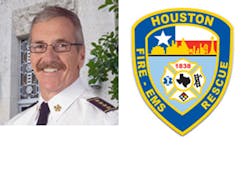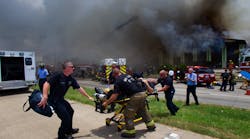Sept. 03--Houston Fire Chief Terry Garrison described a report Tuesday analyzing last year's fatal Southwest Inn fire as outlining the most comprehensive improvements to fire-ground operations and safety since his arrival in 2010.
The 193-page report does not, however, answer the critical question that remains after the enormous blaze on May 31, 2013: What led to the deaths of firefighters Matthew Renaud, Robert Bebee, Robert Garner and Anne Sullivan?
"Honestly, gravity," Garrison told reporters at a Tuesday press conference.
He said fires move faster today because of construction materials and even experienced firefighters can be victims of unforeseeable, catastrophic events like the roof collapse 15 minutes after crews entered the building that day. He defended the firefighters who entered the burning restaurant and motel as among the department's most experienced, saying he trusts they made appropriate decisions and risk calculations.
"Even if that wasn't the case, I wouldn't say anything," Garrison said. "There's no value in that as an organization."
He clarified that the goal of HFD's report was not to attribute blame for the deaths, nor to determine the cause of the fire. He said the fire's origin would be determined by the State Fire Marshal's Office and the National Institute of Occupational Safety and Health, who are still working on their investigations. Initially, both organizations had said they would release their independent reports by summer's end.
Instead, the directive Garrison said he gave a 20-member committee he formed in June 2013 was to review all decisions, policies and equipment from the fatal fire, as well as earlier incidents where fellow firefighters were injured or killed.
They came back with 210 recommendations ranging from technical enhancements on radios to changes in how families of the fallen are notified.
"I want to emphasize that HFD did not make 200 mistakes on that day," Garrison said.
Some of the recommendations came from smart decisions made during the fire that committee members wanted to formalize and incorporate in training, both big and small, he said.
Every firefighter in the department, which has more than 3,800 members, will go through new training on the policy changes. Assistant Fire Chief Richard Mann expects it will take up to six weeks for each of the 21 districts' members to complete the program.
Mayor Annise Parker lauded the report for making the best of a terrible situation.
"We can always do better," she said in an emailed statement. "We want to learn from this tragedy so we are better prepared to prevent it from happening again."
Eleven Houston firefighters have died on duty since 2000. The May 2013 fire was the deadliest in the department's 118-year history. All were killed in burning buildings during rapid internal sweeps intended to suppress the fire while searching for victims.
'Balancing risks'
Houston fire officials have said their philosophy remains aggressive, but defended it as the only way to save lives. Garrison said "aggressive" is a misleading word.
"We are calculated with our aggression, balancing risks," he said.
State and federal investigators have previously critiqued the department's aggressive suppression strategies. In five reports since 2000, they listed problems with crew coordination, communication and risk assessment before entering buildings.
The Houston Chronicle requested copies of numbered bulletins issued under the two most recent fire chiefs before the Southwest Inn fire. The internal memos, about 100 since January 2004, detail changes to department policy.
After a sweep of changes in 2005 under the leadership of a new chief, the memos show just two amendments to the "Emergency Operations" volume of the guidelines, one on basket rescues and another on responses to high rises.
That stands in stark contrast to the recent report that has 46 pages of recommendations, 20 pages of which list proposals to tweak fire-ground operations and training.
After the report was leaked to media Monday, much of the scrutiny has focused on radios. The department had started using a new system just a month before the May 31 fire and at least 20 pages of the report reviewed technical and human errors.
"The radios did not make the roof collapse," Garrison said, acknowledging they did create obstacles for the rescue attempt that followed.
After the department's previous radio system failed in April 2013, HFD was forced to start using the new system before it had finished a few final tweaks, Mann said.
Raised questions
Alvin White, interim president of the fire union, noted in a press release that they had raised questions about the early switch in a letter to Garrison weeks before the fatal fire.
"It is obvious from the conclusions contained within this report there are still areas that need further scrutiny," White wrote.
One section describes the repeated attempts of rescue crews to communicate with leaders coordinating the scene, forcing them, at times, to "return outside" to relay their messages.
"Due to an excessive number of people trying to transmit messages, company officers were simply unable to communicate on the radio," read the report.
More than 500 radio transmissions weren't received because of the volume of traffic and the software did not prioritize transmissions. For instance, the incident commander could be blocked from delivering critical information by a crew member radioing that they had entered the building.
Mann said the fatal fire exposed flaws in the young radio system, some of which have already been fixed.
A Motorola Solutions spokesman confirmed the company has been working with HFD to tweak its software and develop new digital radios. Mann estimated each radio costs $5,000.
Three changes already have been made that prioritize whose transmissions go through during times with heavy traffic and that reduce the amount of dead air caused by software time limits and accidental button pushes, Mann said. He expects two other changes to roll out this fall. A sixth, he said, remains in development.
The Southwest Inn fire was not the preferred way to field test a new radio system, but Mann said it nonetheless fueled important discussion and highlighted technical flaws.
"If it wasn't for May 31, we could be sitting here today without these six changes being made and not knowing we needed those changes," he said.
Copyright 2014 - Houston Chronicle







